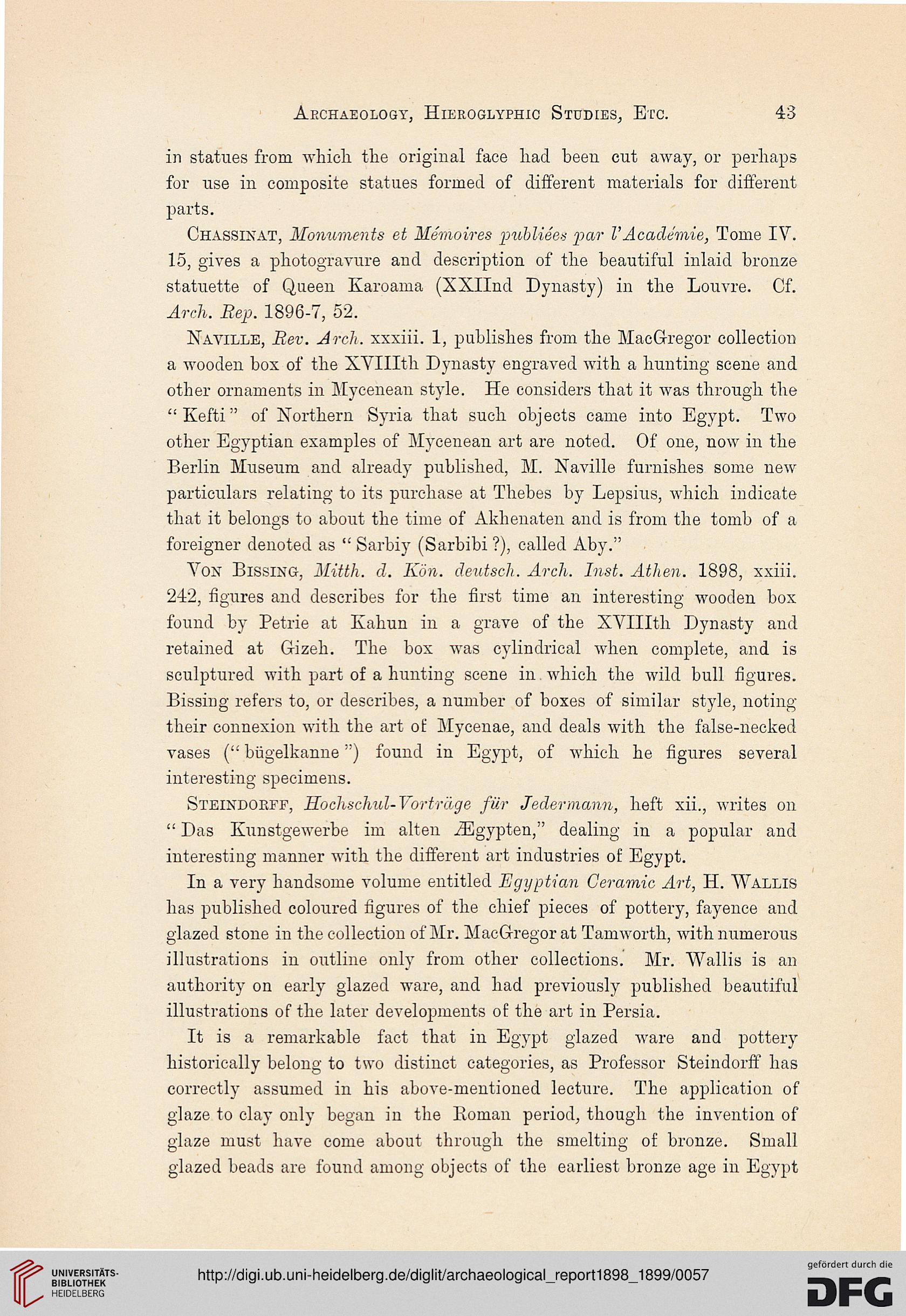Archaeology, Hieroglyphic Studies, Etc.
43
in statues from which the original face had been cut away, or perhaps
for use in composite statues formed of different materials for different
parts.
Chassinat, Monuments et Memoires publiees par V Academic, Tome IV.
15, gives a photogravure and description of the beautiful inlaid bronze
statuette of Queen Karoama (XXIInd Dynasty) in the Louvre. Cf.
Arch. Rep. 1896-7, 52.
Naville, Rev. Arch, xxxiii. 1, publishes from the MacGregor collection
a wooden box of the XVIIIth Dynasty engraved with a hunting scene and
other ornaments in Mycenean style. He considers that it was through the
"Kefti" of Northern Syria that such objects came into Egypt. Two
other Egyptian examples of Mycenean art are noted. Of one, now in the
Berlin Museum and already published, M. Naville furnishes some new
particulars relating to its purchase at Thebes by Lepsius, which indicate
that it belongs to about the time of Akbenaten and is from the tomb of a
foreigner denoted as " Sarbiy (Sarbibi ?), called Aby."
Von Bissing, Mitth. d. Kofi, deutsch. Arch. Inst. Athen. 1898, xxiii.
242, figures and describes for the first time an interesting wooden box
found by Petrie at Kahun in a grave of the XVIIIth Dynasty and
retained at G-izeh. The box was cylindrical when complete, and is
sculptured with part of a hunting scene in . which the wild bull figures.
Bissing refers to, or describes, a number of boxes of similar style, noting
their connexion with the art of Mycenae, and deals with the false-necked
vases (" biigelkanne") found in Egypt, of which he figures several
interesting specimens.
Steindorff, Sochschul-Vortriige fiir Jedermann, heft xii., writes on
" Das Kunstgewerbe im alten .ZEgypten," dealing in a popular and
interesting manner with the different art industries of Egypt.
In a very handsome volume entitled Egyptian Ceramic Art, H. Wallis
has published coloured figures of the chief pieces of pottery, fayence and
glazed stone in the collection of Mr. MacGregor at Tarn worth, with numerous
illustrations in outline only from other collections. Mr. Wallis is an
authority on early glazed ware, and had previously published beautiful
illustrations of the later developments of the art in Persia.
It is a remarkable fact that in Egypt glazed ware and jDottery
historically belong to two distinct categories, as Professor Steindorff has
correctly assumed in his above-mentioned lecture. The application of
glaze to clay only began in the Koman period, though the invention of
glaze must have come about through the smelting of bronze. Small
glazed beads are found among objects of the earliest bronze age in Egypt
43
in statues from which the original face had been cut away, or perhaps
for use in composite statues formed of different materials for different
parts.
Chassinat, Monuments et Memoires publiees par V Academic, Tome IV.
15, gives a photogravure and description of the beautiful inlaid bronze
statuette of Queen Karoama (XXIInd Dynasty) in the Louvre. Cf.
Arch. Rep. 1896-7, 52.
Naville, Rev. Arch, xxxiii. 1, publishes from the MacGregor collection
a wooden box of the XVIIIth Dynasty engraved with a hunting scene and
other ornaments in Mycenean style. He considers that it was through the
"Kefti" of Northern Syria that such objects came into Egypt. Two
other Egyptian examples of Mycenean art are noted. Of one, now in the
Berlin Museum and already published, M. Naville furnishes some new
particulars relating to its purchase at Thebes by Lepsius, which indicate
that it belongs to about the time of Akbenaten and is from the tomb of a
foreigner denoted as " Sarbiy (Sarbibi ?), called Aby."
Von Bissing, Mitth. d. Kofi, deutsch. Arch. Inst. Athen. 1898, xxiii.
242, figures and describes for the first time an interesting wooden box
found by Petrie at Kahun in a grave of the XVIIIth Dynasty and
retained at G-izeh. The box was cylindrical when complete, and is
sculptured with part of a hunting scene in . which the wild bull figures.
Bissing refers to, or describes, a number of boxes of similar style, noting
their connexion with the art of Mycenae, and deals with the false-necked
vases (" biigelkanne") found in Egypt, of which he figures several
interesting specimens.
Steindorff, Sochschul-Vortriige fiir Jedermann, heft xii., writes on
" Das Kunstgewerbe im alten .ZEgypten," dealing in a popular and
interesting manner with the different art industries of Egypt.
In a very handsome volume entitled Egyptian Ceramic Art, H. Wallis
has published coloured figures of the chief pieces of pottery, fayence and
glazed stone in the collection of Mr. MacGregor at Tarn worth, with numerous
illustrations in outline only from other collections. Mr. Wallis is an
authority on early glazed ware, and had previously published beautiful
illustrations of the later developments of the art in Persia.
It is a remarkable fact that in Egypt glazed ware and jDottery
historically belong to two distinct categories, as Professor Steindorff has
correctly assumed in his above-mentioned lecture. The application of
glaze to clay only began in the Koman period, though the invention of
glaze must have come about through the smelting of bronze. Small
glazed beads are found among objects of the earliest bronze age in Egypt





